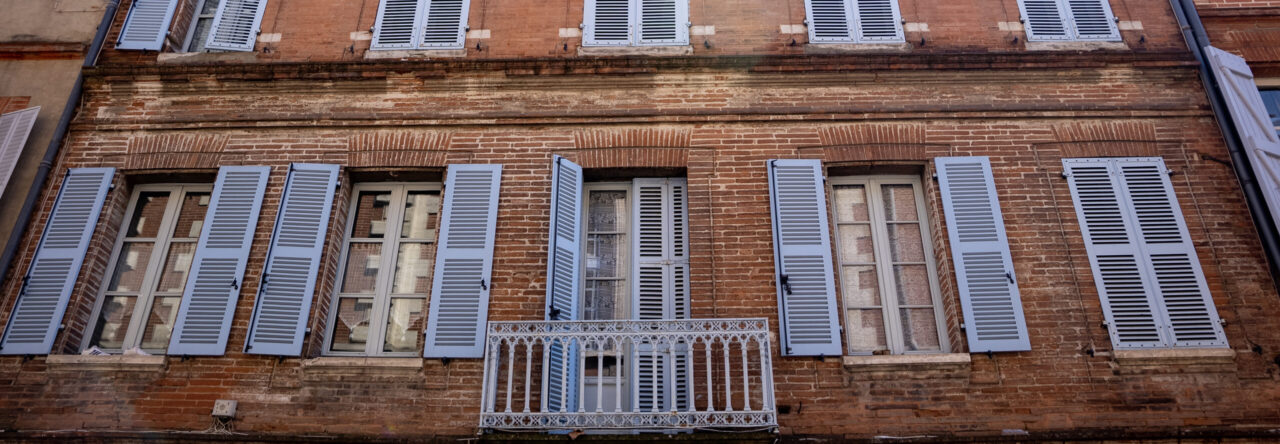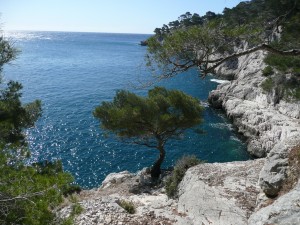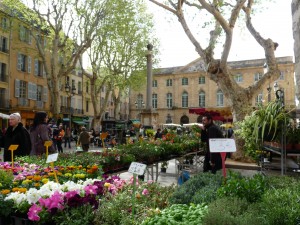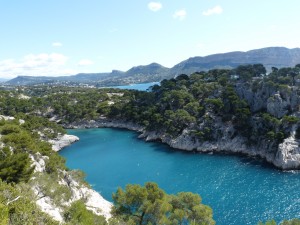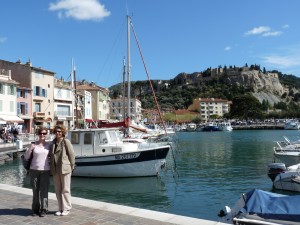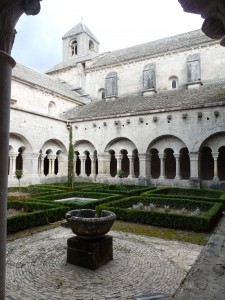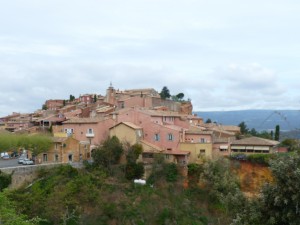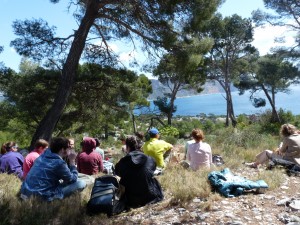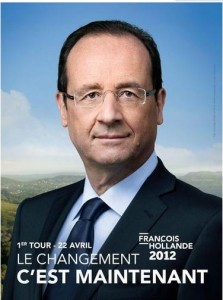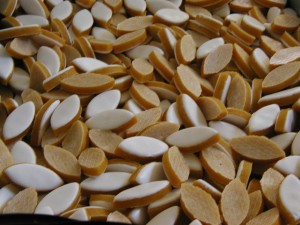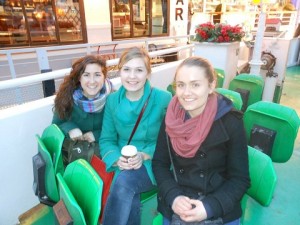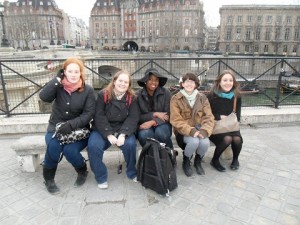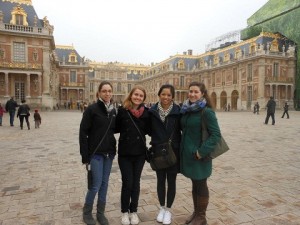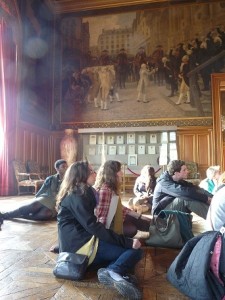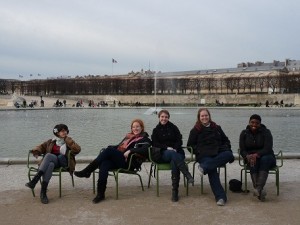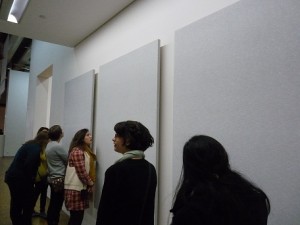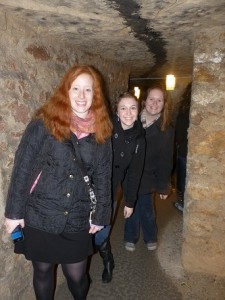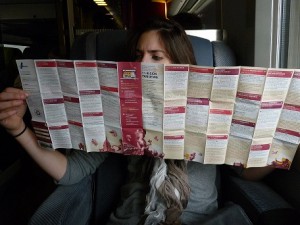The first week of orientation, the students participated in a workshop with the artist Mathias Poisson, a visual artist and choreographer whose work deals with perceptions of space and who helped the students understand the meaning of being blind. Here are some photos.
Category: La Une in English Page 15 of 17
« La Faim des Haricots » is a small restaurant that is hidden by its surrounding buildings, but whose brightly-colored sign immediately attracts the eye. It’s on rue du Puits Vert in Toulouse. Its interior isn’t very big, but the tables are organized in a way that allows lots of people to eat there at once. The tables are mostly on the ground floor, but you can eat outside as well as on a mezzanine. But be careful! The ceiling is fairly low, as my friend, who’s a bit taller than me, discovered when she aloofly bumped her head. The atmosphere is friendly and relaxed. The food is vegetarian, and you can try a variety of dishes. It reminds me a bit of the cafeteria at Dickinson College because it’s an all-you-can-eat buffet. I’ve been there twice now and I know the menu very well. There are vegetable tarts similar to quiches, soups, a main course, and various desserts. Each table gets a basket of bread, but when I went with other American students, we got a second serving of bread. Low prices are also a good quality of the restaurant. You can eat a lot for less than 11 or 12 Euros. “La Faim des Haricots” is similar yet different from the Dickinson cafeteria because everyone talks at the same time and its very loud, but not quite as loud as Dickinson. Some people are bothered by the noise, but I find it comforting. Of course, I don’t really miss the cafeteria that much, but a bit of familiarity is reassuring when you’re in a different country for the first time like me. The restaurant suited me well. I had two good experiences at “La Faim des Haricots” and I’d love to go back again.
A few weeks ago, I got a phone call from my grandmother’s best friend, whom I’d never met before. She’s French and lives in the United States, but she came back to France to visit her sister in Paris. My grandmother had told her I was in Toulouse, so she called me to ask if I wanted to visit her in Paris over the weekend. She offered to pay for my train ticket and she wanted to take me to the theatre Saturday night. How could I refuse?
After a six-hour train ride, a walk through an outdoor market and a visit to Sacré Coeur, the Arc du Triomphe and the Champs-Elysées, my new “aunt” took me to the Théâtre de l’Atelier. The theatre isn’t too far from a bigger, more well-known theatre called the Opera Garnier, which is a sacred temple of art whose majesty lifts the spirit even just with its outside appearance…but I refused to visit it earlier in the day.
Why? Theaters are my favorite places. The space, the shadows, the silence…all of these qualities bring about unequalled peaceful and magical qualities. But after the end of my artistic career, once I had definitely left these places, entering a theatre became extremely painful. But in Paris, I sat in the second balcony of a small theatre, watching a play called “The Father”. The play tells the story of an old man who is losing his memory and of how his daughter takes care of him. As the story unfolds, you discover that it’s told from the father’s point of view, as the events do not happen chronologically.
I was afraid to go to this play because the theatre reminds me of something I miss and also because the play was in French. It’s true that I cried for a moment at the beginning, when the stage first lit up. But afterwards, the story enveloped me and I forgot that it was in French. The words weren’t too difficult, maybe because the magic of the theatre and the universal language of the arts are always comprehensible.
My second full weekend in Toulouse, my hosts invited me to come with them to the Lot, an area of the Midi-Pyrénées region north of Montauban. The family has shared a house there with another family for the past few years, and they rent it to other people when they aren’t using it. We left early Saturday morning to take advantage of the great weather, 30°C and sunny, according to the forecast. What more could you want?
After an hour and a half on the road, we arrived in la Garnède, a group of country houses in a valley of the Midi-Pyrénées region. When I got out of the car, I was immediately reminded of the French countryside: peace and quiet, beautiful nature, and an incredible view. First we had lunch and then we went for a walk to gather blackberries, figs and plums. Unfortunately, the South of France had a very dry summer and most of the fruit wasn’t very good. We spent the rest of the day relaxing by the pool, but because of how cold the temperature was, only the bravest of us went for a dip. At the late afternoon, two families joined us for dinner and we prepared a good, simple meal together, followed by cheese, an orange cake and a chocolate cake.
The next day, we woke up bright and early, right after sunrise. For breakfast, I tried chestnut cream, good spread on bread or mixed with fresh cheese, for the first time. It reminded me of Nutella and of the South-American specialty, dulce de leche. Although chestnut cream is not a regional specialty, I liked it a lot and I bought a jar when I got back to Toulouse. After breakfast, we went for another walk, but this time we got lost in a field for a long time and didn’t know how to get back home. Thankfully, my host had her iPhone with her and thanks to the practical GoogleMaps app, we were able to get our bearings and find our way home again. Once we got back to la Garnède, the families and I prepared lunch together. We sat at the table all afternoon and once we had digested everything, some of us swam a bit more before leaving for Toulouse.
This weekend in the countryside was very relaxed and I took advantage of the peacefulness and of the beautiful weather. These two days also allowed me to visit a part of the Midi-Pyrénées that is completely different from the city, where I spend most of my time. I also got to meet my hosts’ friends, whom I didn’t know yet and whom I’m sure I’ll see fairly often throughout the semester.
Last weekend I was lucky: my aunt and uncle were in Nizas visiting friends. Nizas is only two hours away from Toulouse by train. Because it would have been too difficult for them to come here, I decided to go to their little vacation village.
Nizas is as beautiful as it is small: it has a population of only 600! During my walk around the village with my aunt, I had the chance to admire the beautiful vineyards and the old castle walls. We spent a long time talking to my family and to their English friends, who have travelled around the world. The next day, we went to Pezenas, a city on the coast. We explored charming shops and stopped to listen to a musician singing Edith Piaf songs.
Finally, I took the train to come back to Toulouse. My train connections were long enough that I was able to explore some small cities in the Languedoc: in particular, Agde and Narbonne. It was an excellent weekend and I’m looking forward to more opportunities to travel this semester.
Every student has some special memory of the final final trip to Provence.
On my vacation to Aix en Provence, I saw the gorgeous region of Cassis. In the morning, I was able to walk through the town market. One of the items that this regions is known for is their heavenly smelling lavender. Right on the beach of the Mediterranean Sea, one could not help but bath in the scent of the ocean. Not bad for my first time at the beach!
Provence is the most famous region in France with its unique scenery creating a part of that fame. Even if you can’t see it in the photo above, Provence has a reputation for very blue skies, which is one reason why Provence is depicted in many paintings. It is countryside with a lot of low-lying vegetation and trees without many leaves because of the makeup of the soil and the lack of rain. The region has a lot of wind because of the Mistral, which can create high-speed winds in the region. It is a beautiful countryside with a lot of character that helps to create the popularity of the region.
Although it rained, I found Aix-en-Provence to be very pretty. As a city, it is vibrant, chic, and above all young. If you desire, you can buy only organic product. You have to rely on the frequent street markets, the grocery stores, and the street venders because the cost of living is quite expensive, but you can always support local producers. Having seen all of these shops and having spoken with a woman who sells organic soap, it seems to me that this city is very conscientious.
Sarah H:
During our visit to Provence we hiked in the Calanques. We started our adventure in the village of Cassis. Then we climbed the calaque called Port-Miou. The landscape was incredible and we all took many beautiful photos of the blue water (a blue similar to what you would find on a post card). We continued to walk until 12:30 or 1 when we stopped to eat a picnic of sandwiches we had brought from Aix. After we hiked a bit higher before turning around to return to Cassis. During our free time in Cassis the members of the group all explored different areas. Some people ate ice cream in a cafe while others rested on the beach. After, once we had returned to the bus, we were all very tired but we agreed that we had passed an agreeable day.
The town of Cassis is a great place to visit, as well as an ancient fishing port. Walking
through the tiny town’s village streets, you stumble upon beautiful old buildings painted
in the beautiful pastel colors of the Provence region. The town boasts medieval
fountains, an open-air artists’ market, and a gorgeous harbor. Cassis used to be just a
small fishing port, but these smaller boats now share the harbor with some impressive
yachts and tourists boats that take people out to explore the calanques and the pristine
blue water of the Mediterranean.
On the 3rd day of our vacation, we went to Sénanque Abbey, an abbey for Cistercian monks located between Aix-en-Provence and the town Roussillon. During our visit, we saw the monk’s room, the church, and the decision-making room. In particular, I was struck by how hard the life of a monk was in the past. Our guide told us that the monks of the middle ages slept on the ground on a straw mattress. Of course, there was no heating in that era, so the only comfort the monks had was that they slept on ground that had been cooked (which holds more heat). All the monks slept in the same room, and they only had little curtains around their mattress for privacy. In addition, during the summer, the monks would get up at 2 am! However, today the life of a monk isn’t so hard. All the monks have their own heated room with a bed.
Completely different from any other town in France the bright and contrasting colors of Roussillon are nothing less than impressive. We walked through the ochre footpath to marvel at the natural pigmented formations that have existed since the prehistoric time. I didn’t like Roussillon because of its antiquity or for its UNESCO status, but for its natural and powerful beauty.
I could not have imagined a better day for my birthday in the Calanques. The weather was beautiful with an amazing sky – it was a blue that you can only see in the Calanques. The hike was difficult at times with the rocks and the slopes, but it was worth it to see the views. At each turn the hills and the Mediterranean Sea seemed to be even more beautiful. When it was time for out picnic, we were very happy to eat and take a nap in the sun.
My favorite activity during our voyage in Provence was definitely the hike in the Calanques. The colors of the Calanques were without equal: the bright blue-green of the water, the vibrant green of the trees, and the white of the cliffs combined to be a feast for the eyes. Furthermore, our guide expertly brought us to specific areas in the Calanques where the view left us speechless. We also passed a very pleasant lunch in picnicking and laying out in the sun. All-in-all, this hike was one of my favorite experiences in France and I would very much like to return to the Calanques and to Cassis in the summer when it must surely be even more magnificent.”
Ellen Aldin
The United States is not the only country with presidential elections in 2012; France has them too. For my internship, I have the opportunity to work in a polling station, and here’s what I noticed for the April 23 elections:
– The voting process is very communal. When a person votes, he has a conversation with the people that are working there; it’s a social event! Also, instead of having absentee ballots, the French that cannot be present at their polling place on Election Day vote by procuration, which is giving the right to vote to someone else in your place. In this case, the person that cannot vote has to communicate his choice to the person to whom he has given procuration, an extremely personal choice in the United States. However, in France, one can discuss the election and personal choices regarding the elections pretty freely; it’s not as private.
– The votes are revealed publicly. At my polling place, when the voting had finished, the envelopes with the ballots inside were opened in front of a small crowd, which was open to the public. When the workers opened the envelopes, they said the name on the ballot inside out loud so that everyone present could hear the trends in that particular polling place at the same time.
But this process is going to continue; in France, the presidential elections use a two-step system. This means that the first election has over 2 candidates, and the purpose of this election is to take the two candidates with the most votes to go head to head against each other in the second election. The winner of this second election wins the presidency. The first election already happened and Nicolas Sarkozy and François Hollande are the candidates for the second election on May 7. Therefore, there will be another election and I can see the nuances between the two elections in a French presidential election.
It is impossible to talk about French desserts without referencing Marcel Proust. Just thinking about our visit to the Léonard Parli calisson factory in Aix-en-Provence is enough to remind me of madeleines and memories. To summarize this revolutionary and infrequently punctuated section of Remembrance of Things Passed, Proust stumbles upon the link between everyday experiences and memory after taking a bite of a madeleine dipped in tea. This famous eureka moment inspired him to question why the past is hidden in the most innocuous of things, waiting to leap out, unbidden, from the smell of the ocean or the scrap of a forgotten melody.
Of course, Proust explains it best: “But when from a long-distant past nothing subsists, after the people are dead, after the things are broken and scattered, taste and smell alone, more fragile but more enduring, more unsubstantial, more persistent, more faithful, remain poised a long time, like souls, remembering, waiting, hoping, amid the ruins of all the rest, and bear unflinchingly, in the tiny and almost impalpable drop of their essence, the vast structure of recollection.”
I like to think of these small, powerful bits of sensory detritus that we encounter on a daily basis as unexpected yet welcome visitors, magi if you will, bearing gifts of memory. In spite of all of the time that has passed, the sound of someone shuffling a deck of cards makes me think of playing “War” with my great-grandmother. The smell of fresh basil brings me back home to Sunday afternoons spent watching my dad make meatballs and gravy. And now, the taste of calissons reminds me of the magic of Provence and the experience of studying abroad as a whole. Proust can keep his madeleines—pass me another calisson, please.
During my winter break, I visited the city of Marrakech in southern Morocco. I along with twenty-seven other Americans, spent the weekend exploring the city but we also took trips to the Ourika valley and the Atlas Mountains. In Marrakech, we visited the souks, the Jamma El Fna Square, the Ben Youssef Mosque and the Marrakech Museum. Outside the city, we visited a Berber family (the native people to this region of Morocco) who live just outside the city, where we drank mint tea and ate traditional Berber bread.
Morocco’s national drink is mint tea, a green tea with a ton of sugar in it; it’s delicious. One, night, we ate dinner in the Djemma el Fna , where we were served brochettes of grilled chicken, beef, lamb, and vegetables, as well bread, olives, fries, and mint tea. It was an interesting experience because while we were eating dinner outside, many people approached us tried to sell us food and cigarettes, and children tried to sell us packages of tissues. We also ate lots of tajines and couscous during our stay.
One of the most exciting parts of the trips was going canyoning in the Atlas mountains. It was an exhilarating experience climbing down waterfalls, and jumping and wading through the streams. We began our journey a little bit late (everything in Morocco happens about two hours after it’s scheduled to begin) so by the time we finished it was dark outside but it was still an amazing afternoon.
It was also fun to explore the souks and barter with the shop owners. In one store I, along with three friends, found scarves we liked. The shop owner originally said they cost 200 durhams each (20 euros) and we offered 200 durhams for four scarves. He said no and went down to 150 each etc… When he wouldn’t go any lower (we were at about 70 durhams each) we said thank you and walked away. About thirty seconds later he followed us and agreed to sell us four scarves for what we had originally offered.
I loved my time in Morocco. It was nice to not have to plan anything but to follow a schedule and have someone else be in charge. It was also nice to spend time in a culture so different from any I had previously visited (even though the cat calls did start get to annoying). In the end, it was nice to come back to my home in Toulouse.
Lauren in Lisbon
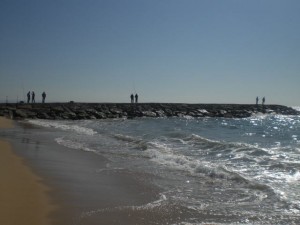 Lisbon is an incredible beautiful city, and the beach is equally as gorgeous as the city! After spending a few days wandering the around, we decided that we needed a bit of sun and relaxation. Despite how difficult it was to find the right bus to get us there, it ended up being the best part of our trip! Discovering the other side of the Atlantic, I think, is the most impressive experience I have had in my european travels to date.
Lisbon is an incredible beautiful city, and the beach is equally as gorgeous as the city! After spending a few days wandering the around, we decided that we needed a bit of sun and relaxation. Despite how difficult it was to find the right bus to get us there, it ended up being the best part of our trip! Discovering the other side of the Atlantic, I think, is the most impressive experience I have had in my european travels to date.
